The Advent of Modern Mobile Devices in the Enterprise
Modern mobile devices running the Android operating system were introduced into the enterprise landscape ten years ago. These devices replaced the generation of aging Windows CE, BlackBerry, and Symbian devices that preceded them.
There was a period where Windows mobile devices were poised to make a comeback, but that effort died in 2014. After that, Android devices have become the de-facto standard for devices inside the four walls. Companies such as Zebra, Honeywell, Datalogic, and Panasonic continue to bring new Android devices to the market.
These devices get faster and have more hardware capabilities, such as improved scanners, imagers, cameras, or sensors. On the software side, the devices continue to become more powerful. New applications that can run on these devices continue to add more value to the enterprise: Tools for data capture, communication, customer engagement, and reporting continue to improve the day-to-day jobs of end-users and help businesses get more visibility into what is happening across their organizations.
Who is this Guide for?
Enterprises looking to roll out new Android mobile devices or companies interested in replacing legacy devices with newer hardware.
This guide highlights key details that have helped organizations smoothly and successfully transition to new mobile technologies. Success in the areas listed below will typically predict how prosperous an organization will be from upgraded devices.
Download the Modern Mobility Guide
Learn about the 10 fundamental areas that are required to successfully deploy new mobile technology.
What is Considered a Successful Mobile Deployment?
Many factors are taken into consideration for what could be labeled a “successful deployment,” but these are the three core areas we believe in most:
Schedule and Budget – Map out a realistic schedule and budget for your deployment to better understand what contingency plans may need to be set. It is essential to add a buffer zone in large projects in case of future budget and time constraints; this will help keep you on track to deliver as planned while also protecting your investment.
Employee Adoption – Consider surveying your team to gauge the need for mobile deployment in the field. If the majority of employees feel new devices will streamline their work experience, you can be confident that a deployment will strengthen your organization by making daily tasks more accessible and more efficient.
Improvement in Business – The benefits of implementing new technology greatly outweigh the cost of the initial investment. If a new mobile device fleet improves your organization on all levels of business, this technology will be highly beneficial.
The following are the core areas that we have seen in successful enterprise mobile device deployments:
- Planning – Perform requirements and define the principles of how you will leverage mobility.
- Testing – Run proof and concepts, be able to test and measure to make better decisions.
- Tooling – Invest in the tooling for developing apps, managing devices, and supporting devices.
- Process – Leverage best practices for deploying, managing, and supporting devices over their lifetime.
From these areas, we have identified ten fundamentals that you should do to find success in your modern mobility deployment.
1
Develop Formal Principles and Requirements
Base your plans on proper preparation and analysis. When you set out on the journey of replacing legacy mobile devices or introducing new mobile devices, you need to start that journey with a proper foundation. That foundation is “formal requirements” and “written principles” upon which key stakeholders agree. Sometimes plans are not built with the proper preparation and analysis needed to be successful. When setting out to replace legacy mobile devices or implement new technology, you need to start with a solid foundation of “formal requirements” and “written principles” that your team can agree on from the start.
What you should be assessing:
Principles – Set guiding principles for why you are rolling out new mobile devices and what you would like to gain from them. Principles should be a shortlist of cornerstones that you use to evaluate and prioritize your decision-making. Example principles include:
- “Devices will be used by employees to improve their job, not to create more work.”
- “Devices will be cheaper to support over the next five years than our current process.”
- “We must have new devices rolled out by the end of Q3 to meet regulatory compliance.”
- “We will replace our devices as cheaply as possible and replace them often.”
- “Devices will be used to make our processes better, not to replace our existing processes.”
Requirements Gathering – Spend 1-2 weeks collecting feedback and compiling a wishlist from the different parts of your organization on the requirements they have for new mobile devices. The teams you meet with should include Production, Operations, IT, Helpdesk, and Field Users. You should collect as much feedback as possible to best understand the wishes of your employees. We will typically create two groups of requirements, functional (operational) and non-functional (technical).
1). Functional Requirements Examples:
- “Devices should be able to scan barcodes and show the last five warehouses a shipping container has visited.”
- “Employees should be able to use the device for voice phone calls.”
- “Employees should be able to update their calendar and HR availability.”
2). Non-Functional Requirements Examples:
- “Devices should support encryption of all data on the device.”
- “Device screen should be visible in full daylight.”
- “App should cache data locally to handle poor connectivity.”
Prioritizing and Backlog – If you did a reasonable job gathering requirements, you should now have a list filled with hundreds of responses. Once the wish list is organized, it is time to identify what requirements are a “Must Have,” “Nice to Have,” and a “Future Backlog.”
Key Takeaways
When you ask people what they need, you will have better luck getting their buy-in when you need help down the road.
Make sure mobile devices meet the core requirements.
With a limited budget, amount of resources, and time, you need to plan for where you will invest based on your list of principles and priorities.
2
Run Proof of Concept Tests with Multiple Hardware Options
A proof of concept (POC) is a tool that allows you to test out concepts and better understand what works and what doesn’t. For mobile devices, we recommend picking a few key jobs within your organization and having them leverage the devices to help with their day-to-day tasks for a few weeks.
What you should be assessing:
Test Accessories – Test different accessories with your mobile devices, including printers, charging cradles, ring scanners, headsets, etc.
Feedback from End-Users – Have a good channel for communication with end-users. You want all of their input, both good and bad. They should feel comfortable giving you negative feedback.
Measure – You need to be able to build tooling to measure everything about your POCs. Users may tell you what they feel, but accurate app usage and device performance analytics will give you a sense of what actually needs to be improved.
Run them as Quickly as Possible – Ideally, POCs should last less than two months. This timeframe should be enough time to collect quantitative feedback and data from device usage.
Avoid Cognitive Biases – Humans have a problem of always trying to prove what we believe to be true. POCs should be run to create a hypothesis and prove/disprove it… not to prove one idea correct.
Try Different Vendors – Try hardware from different vendors (e.g., Zebra, Samsung, Honeywell, DataLogic). Depending on the size of your rollout, you may be able to request demo units of hardware to run your POCs.
Assume POCs will be Throw-Away – The only part of POCs you should plan on keeping will be Learnings. Assume that all software and hardware from a POC will be throw-away.
Key Takeaways
In 3-5 years you will need to justify the decision to your board and leadership teams. If your next CEO starts working in two years and asks, “Why did we roll out Android Devices instead of iOS,” you will be prepared with analytics and employee feedback to strengthen your case.
Having multiple device options from different vendors will give you more flexibility in device pricing and budgeting.
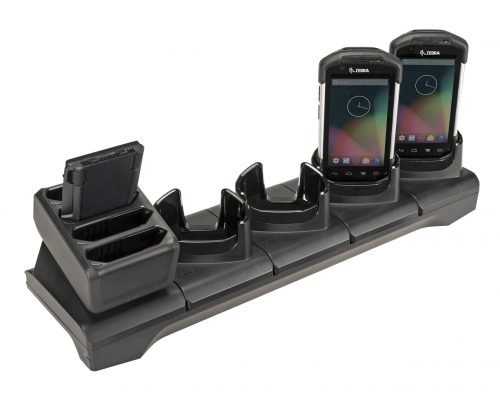
3
Perform an Infrastructure Readiness Assessment
Putting new mobile devices into a facility is not as simple as just plugging them into the wall and expecting them to work. There are several infrastructure and environment requirements that you should assess before deploying new mobile devices.
What you should be assessing:
Wireless Networks – WiFi networks seem to have become ubiquitous across most enterprises, but we still run across organizations with legacy wifi systems, limited wifi coverage, or no Wi-Fi. You should assess your wireless network to understand if you need to plan for limited connectivity with your apps or if you need to invest in upgrading your wireless infrastructure.
Backhaul Network – You may (or may not) be surprised by the number of customers that we work with who are still using backhaul network connections with speeds of less than 1.5Mbps. Modern apps and devices can consume a lot more bandwidth (think about the last 500 MB OS “Patch” that Apple or Samsung pushed to your consumer device).
Cellular Networks – Similar to wireless networks, cellular networks have become pretty common across most modern cities. However, there are still plenty of locations where field users or delivery drivers will not be able to get cellular coverage. Be sure to understand where devices will be used and if there will be limited coverage.
Security Infrastructure – New mobile devices can create a new endpoint that hackers can use to gain entry to your networks. You should assess your endpoint security controls like your firewalls, VPNs, Monitoring, and Network VLAN segmentation.
Power – If you plan to put devices in charging cradles, find out if you have appropriate power connectivity in your facility. Devices all charging in one cradle bank could overload a plug with limited amperage.
Physical Storage – Determine if your devices need to be stored in a locked room or cabinet to restrict access when they are not in use. We recommend charging cradles where the devices can connect and update software and patches overnight.
Site Consistency – There are endless variations between different end-user facilities, but maintaining a consistent site template for deploying devices allows you to stay in control of your rollout and deployment plans.
Key Takeaways
You don’t want to invest money in a new device fleet if the surrounding infrastructure can’t support your new hardware.

4
Understand the Application Technologies You Will Use
The application technologies you use for your mobile devices will impact the hardware and end-user experience. Analyze the variety of technologies to understand better which will be best for your organization.
What you should be assessing:
Green Screen Apps – Lots of companies still use legacy green-screen applications. Usually, it will be easier to migrate to a modern mobile device using the current green screen applications than to come back and replace those apps in the future.
Native Apps – Properly developed native applications can be much more powerful than legacy screen applications. You need to know if investing in new applications will help create more value from your employees’ daily work experience.
Web Apps – Web applications are typically easier to deploy, manage, and update than native applications, but they consume more network bandwidth and may not have the performance or device interaction capabilities you would get from a native app.
Cross-Platform Apps – Hybrid cross-platform applications are written to deploy to multiple device types such as iOS and Android. Common cross-platform languages include Xamarin, React Native, and Flutter. We recommend staying away from cross-platform apps unless you have a very compelling business reason. Cross-platform apps can be more challenging to support over multiple years.
Build vs. Buy vs. Hire – You can build your mobile application, you can buy off-the-shelf applications, or you can hire someone else to build them for you. Depending on your team’s bandwidth and capabilities, you need to determine which of these will work best for you.
Why this is important:
Application development and support can be expensive, so create a plan early on to support the technology over the next five years.
The type of applications you use may impact the features and capabilities of the devices you end up buying.
5
Use a Migration as an Opportunity to Leverage Cloud Technology
Is your organization stuck in 2003 with servers distributed through all of your sites or in data center racks? A mobile migration may be a good time to introduce cloud technologies to help you drive down the business’s ongoing costs.
What you should be looking at:
Cloud-Based MDM/EMM Solutions – We recommend leveraging cloud-based MDMs to manage your devices in the field. The most common solutions we implement for clients include AirWatch, SOTI, Maas360, and MobileIron.
Off the Shelf Line of Business Apps – Some of your existing business applications may be able to be replaced by cloud-based solutions. As you conduct an audit of your application roadmap, determine if anything could be replaced with a cloud solution.
Moving Applications Backends to the Cloud – If you have to update legacy application services or databases, now may be the right time to retire that hardware and move those systems to Azure, AWS, GPC, or another cloud provider.
Key Takeaways
To be able to move fast, you may need to stand up backend services quickly. The cloud-based infrastructure allows you to scale up and down faster. Cloud infrastructure is beneficial for quickly deploying the Proof of Concepts mentioned above.
Leveraging a third-party to help you develop solutions for or manage your devices will be easier (and potentially safer) if your applications are cloud-based.
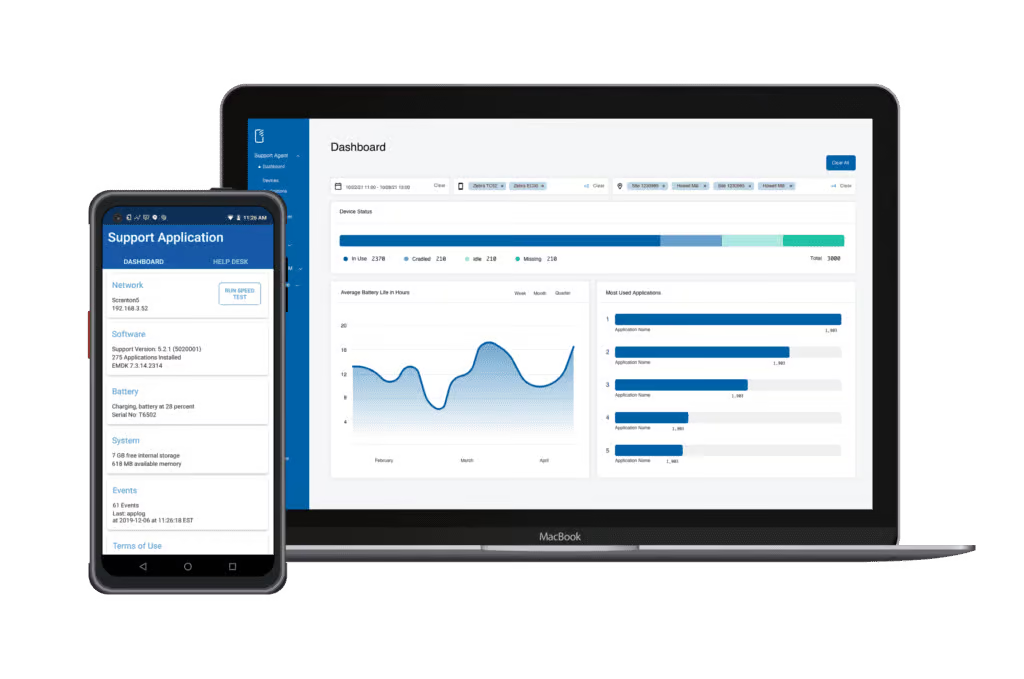
6
Setup Analytics to Create Visibility into the Performance of Your Devices
As mentioned in the POC section above, device analytics are becoming more and more important for managing and supporting devices. You should invest in tools that allow you to perform an analysis based on collected data from devices. Data collection tooling we have seen organizations use include MDM agents (such as SOTI or AirWatch), Application SDK (Such as Crashalytics), or device agents (such as Zebra OVS, Splunk Mint, or BlueFletch Support Agent). For data analysis, you can leverage software such as Splunk, Tableau, PowerBI, or other tools that can quickly build reports.
What you should be assessing:
Device Usage Patterns – Usage patterns of a device include details such as when/how often devices are used, who is using them, and their usage purpose.
Application Information – Being able to see detailed information about specific functionality that users are engaging within an application can help you better understand how to improve future versions of your applications.
Hardware Information – Visibility into hardware info such as battery, memory, CPU, or network details can help you locate and proactively repair misbehaving devices and accessories.
Security Information – To help you prevent security breaches, it is helpful to get insight into any devices with misconfigured, unpatched, or have unapproved/malicious applications.
Key Takeaways
To help you prevent security breaches, it is helpful to get insight into any devices with misconfigured, unpatched, or have unapproved/malicious applications
Understanding usage patterns will help your business understand how to optimize usage and support of your devices.
7
Invest in Device Golden Images, Rebuild Processes, and an MDM Strategy
Devices can not be deployed and used in the field without the proper configuration or support tooling. You will need to determine and track the settings and configuration that make up the base image for your devices. This is typically called a “Base Image,” “Golden Image,” “First Article,” or “Standard Operating Environment.”
Things that you should plan for:
Device Configuration and Security Settings – Determine the base settings your device will leverage. These typically include Network Setting, Security Settings, Screen Settings, and Accessory settings.
Rebuild Process – If a device OS issue or major software issue occurs in the field, a rebuild of a device may be your fastest option to fix that device. A device “Rebuild” process typically entails resetting the device to a factor state and reinstalling your base image with all of your specific configurations and business applications.
Patch Rollout Process – When you roll out devices, they will generally be on one patch level of an OS. As time goes on, you may not be able to purchase devices at that patch level from the manufacturer. You will need a process to update all of your devices to a consistent patch at an OS level to maintain your security posture.
MDM Setup and Configuration – MDM systems allow you to group your devices into different organizational structures. This structure can make it easier to deploy software by location or pilot groups. Additionally, you need to get your team trained, and up to speed on the tools you leverage. You should plan this structure as soon as possible because we have observed too many situations where an under-trained client employee has caused a production outage through a wrong MDM configuration deployed to production.
Key Takeaways
Properly planned Device Management will help you drive down the cost of supporting devices over the next 3-5 years.
You will have software issues in the field, so you need tools that allow you to quickly isolate, remedy, and deploy updates for those problems.
8
Define a Rollout Process that Involves Phased Deployment
When you decide to put new hardware into the hands of end-users, you need to have an efficient plan that will not disrupt your business’s continuity.
Things that you should plan for:
Hardware Staging and Shipping – Hardware setup, staging, kitting, and shipping can be more time-consuming than you would think. Planning for these activities early can help you quickly deploy hundreds or thousands of devices to your end-users.
Pilot Process – We can’t stress the pilot phase of a rollout enough. The pilot phase is the time to shake out any bugs or issues you will encounter in your full production rollout, preparing your team for a better deployment.
Phased Rollout – After completing deployment at your pilot sites, we recommend an approach that phases up the rollout volumes. For instance, roll to 10 sites week 1, 30 sites week 2, and roll to your remaining sites on week 3.
Deployment Tiger Team – Set up a cross-competency team from different technology and business units to support your rollout. Usually, these teams will include members for operations, support, infrastructure, app development, and training. Depending on the size of your organization, this team may vary in size and complexity.
Key Takeaways
You will encounter problems, so you need a process that will identify and resolve them quickly. A formal process will make deployments faster and cheaper.
9
Leverage Experts to Help with Design, Deployment, and Support
Leveraging companies that specialize in supporting developing applications, designing MDM structure, supporting deployments, device repair, and device lifecycle management can help you shortcut many of the items listed above. Their experience, templates, and standard operating procedures will benefit your organization in the long run.
What you should look for in consultants and Managed Service Providers:
Industry Experience – Experience supporting companies similar to yours is key to a good match.
Hardware Experience – Different types of mobile devices and accessories have different nuances. Pick someone familiar with the hardware you have selected.
Technology Acument – The technology landscape is constantly shifting. Look for experts who are keeping up with new options and can communicate to you the pros and cons of different approaches.
Capabilities – Understand what qualifications you need and where you could leverage a third-party service provider. Capabilities to consider include device setup, deployment installation, repair, advanced swap, MDM management, field support, training, development support, help-desk support, and telecom management.
Key Takeaways
Leveraging third parties with specific mobile device experience can help you accelerate your deployment times.
By leveraging external consultants, you can focus your internal resources on your core business areas instead of handling device maintenance and support.
Experienced consultants may be able to help you shortcut many key learnings and processes to support new devices.
10
Plan your Support Process from the Beginning
Plan the necessary support processes from the beginning of your deployment project to ensure a smoother device transition.
What you should plan for with support capabilities:
Support Documentation – Begin to build a support knowledge base (KB) around devices from your testing and initial pilot sites. Any issues you encounter and resolve should become additions to your support KB.
Remote Support Tooling – The value of remote control tools on mobile devices in the field is incredibly high. Budgeting and planning support and remote control tools from the start of a project will make device troubleshooting much easier over the long run.
Infrastructure Troubleshooting – Your support team will need the tooling and capability to isolate and send information about wireless network issues to your infrastructure teams.
Application Troubleshooting – Tools like Firebase Crashalytics can help your support team send valuable details to your application development teams about troubleshooting application issues in the field.
Rebuild/Replace Process – When an employee calls your Helpdesk with a non-resolvable issue, you need to have a process to get a replacement device to them on time (and to get the issue device back to your repair or support team).
Key Takeaways
Well-planned support processes will make rollouts of new devices smoother and cheaper.
Resolving and troubleshooting issues faster will instill more confidence and faster adoption from end-users.
Planning and investing in support upfront will lower the long-term cost of supporting devices in the field.
Summary
To successfully deploy new mobile technology, you will need to gather requirements, plan, design, implement, and support any new devices you introduce to your organization. The following were the key areas we covered in this guide:
- Develop Formal Principles and Requirements
- Run Proof of Concept Test with Multiple Hardware Options
- Perform an Infrastructure Readiness Assessment
- Understand the Application Technologies You Will Use
- Use a Migration as an Opportunity to Leverage Cloud Technology
- Setup Analytics to Create Visibility into the Performance of Your Devices
- Invest in Device Golden Images, Rebuild Processes, and an MDM Strategy
- Define a Rollout Process that Involves Phased Deployment
- Leverage Experts to Help with Design, Deployment, and Support
- Plan Your Support Process from the Beginning
Effective organizations recognize that the investment in new mobile technology can be substantial. We understand that you will be held accountable for producing value and an ROI on this investment.
Download the Modern Mobility Guide
Learn about the 10 fundamental areas that are required to successfully deploy new mobile technology.
